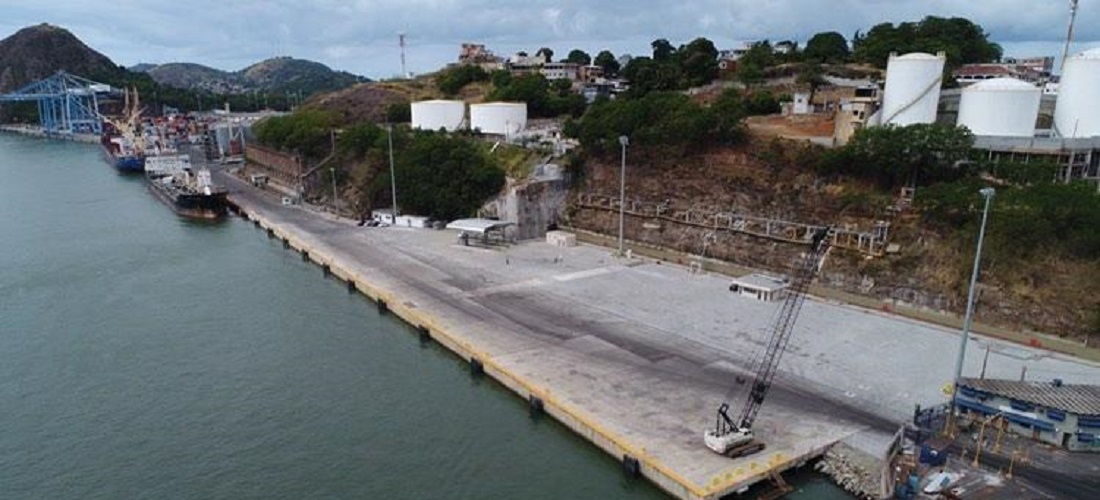
IRS releases customs application for the Atlaia Wharf
Jun, 15, 2020 Posted by Sylvia SchandertWeek 202024
The IRS has released the customs application for the Atalaia Wharf, located in the Port of Vitória, requested by Codesa, the port authority. The multipurpose pier will increase the operational capacity of the Port of Vitória since it can receive all types of cargo.
According to the director of Infrastructure and Operations at Codesa, João Cunhalima, customs was an important step in carrying out the operation of berth 207. With the new concept of runway berths, it will be possible to move, in addition to liquid bulk, solids, such as pig iron, wheat, malt, fertilizers, and coal.
“During the harvest season for solid bulk, we have lots of movement at the Pier. This period begins now and ends in December. Before, only berths 201 and 202, in Capuaba, operated with these types of bulk. We measured the queue of vessels during the harvest. Now, with the new berth 207, we are going to expand our throughput and container capacities. The new pier will be an important asset to make the Port of Vitória more dynamic and more productive “, he explains.
The new wharf replaced two old dolphins and gained 278.9m in length, creating berth 207. The structure has a total area of 19,963 thousand m², of which 10,000 m² are only in the port retro area (for storage and cargo handling). The continuous pier was equipped with 14 bollards – massive iron structure, embedded in the pier, designed to support the turns of the mooring cables – and 12 fenders – an element used in ports and port facilities, for adequate protection between the ship and the mooring. In addition, it has a depth of up to 12.5 meters, making it possible to dock ships with greater cargo capacity.
The new construction will be able to handle cargo liquid and solid bulk, in addition to general products. The berth will also be essential for the project to implement the Liquid Bulk Terminal (TGL), which will be built in Capuaba, Vila Velha.
DataLiner data show that in the first quarter of 2020, the Port of Vitória registered a growth of 1.23% in exports via containers compared to the same period last year, with 14,932.50 TEUs. In the case of container imports, the growth was 1.52%, with a total of 14,253.50 TEUs. (To request a DataLiner demo click here)
Codesa is now awaiting the release of the environmental license to start operations at the pier.
A Receita Federal liberou o pedido de alfandegamento do Cais de Atalaia, localizado no Porto de Vitória, solicitado pela Codesa, autoridade portuária. Com isso, o cais multiuso aumentará a capacidade operacional do Porto de Vitória, já que poderá receber todo tipo de carga.
De acordo com o diretor de Infraestrutura e Operações da Codesa, João Cunhalima, o alfandegamento foi um importante passo para a realização da operação do berço 207. Com a nova concepção de cais corrido, será possível movimentar, além de granéis líquidos, os sólidos, como, por exemplo, gusa, trigo, malte, fertilizantes e carvão, que tem histórico de grandes operações no Porto de Vitória.
“Em época de safra dos granéis sólidos, temos um movimento muito grande no Cais. Esse período começa agora e vai até dezembro. Antes, só os berços 201 e 202, de Capuaba, operavam esses tipos de granéis. Na safra, registramos filas de navios na barra. Agora, com a novo berço 207, vamos ampliar nossa capacidade de movimentação, inclusive para contêineres. O novo cais será um importante ativo para tornar o Porto de Vitória mais dinâmico e mais produtivo”, explica.
O novo cais substituiu dois antigos dolfins, e ganhou 278,9m de extensão, abrigando o berço 207. A estrutura conta com uma área total de 19.963 mil m², sendo de 10 mil m² só de retroárea (para armazenagem e movimentação de carga). O cais contínuo foi dotado de 14 cabeços — estrutura maciça de ferro, encravada no cais, destinada a suportar as voltas dos cabos de amarração — e 12 defensas — elemento utilizado em portos e instalações portuárias, para proteção adequada entre o navio e a estrutura de atracação. Além disso, conta com profundidade de até 12,5 metros de calado, possibilitando a atracação de navios com maior capacidade de carga.
A nova construção poderá atender movimentações de cargas de granéis líquidos e sólidos, além de produtos gerais. O berço do novo cais também será fundamental para o projeto de implantação do Terminal de Granéis Líquidos (TGL), que será construído em Capuaba, Vila Velha.
Dados do DataLiner apontam que no primeiro trimestre de 2020, o Porto de Vitória registrou um crescimento de 1,23% nas exportações via contêiner em relação ao mesmo período do ano passado, com 14.932,50 TEUs embarcados. Já nas importações via contêiner, o crescimento foi de 1,52%, com a movimentação de 14.253,50 TEUs. (Para solicitar um demo do DataLiner clique aqui)
A Codesa aguarda, agora, a liberação da licença ambiental para iniciar as operações no cais.
-
Shipping
Nov, 23, 2023
0
Brazil’s Congress Votes to Regulate Pilotage Activities
-
Sugar and Ethanol
Dec, 26, 2022
0
Sugar line-up: Brazil to ship 1.478 million tonnes
-
Ores
Mar, 14, 2019
0
Argentina’s largest gold mine restarts operations
-
Economy
Jun, 22, 2022
0
Uruguayan peso now the strongest currency in South America


